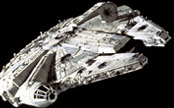Every day, fantastical technology we see in movies like Star Wars comes closer to reality. From aerospace to defense systems to medical devices, chemistry enables amazing feats of science and imagination. In this blog post, we’re going to delve deep into the possibilities with some educational information about chemistry and its role in innovation, so you know fact from fiction.
The innovative products of chemistry lead to cutting edge advancements—applied technology in space exploration, computing, robotics, fuels and more. Chemistry also enables technological advancements that drive innovation, create jobs and enhance safety in our everyday lives.
So before you venture to a galaxy far, far away in the new Star Wars: The Force Awakens film, transport your mind with these cool chemistry facts:
- From heroes to villains to a host of aliens and other strange creatures, a lot of limbs are lost in the Star Wars saga. Most famously in the original trilogy, Luke Skywalker has a cybernetic hand installed to replace the one Darth Vader cut off. Cybernetics, prosthetics and artificial skin are frequently made with the versatile chemistry of silicones. Check out this silicone innovation from researchers in South Korea, as featured in Popular Science: Researchers built a new artificial skin that can jacket prosthetic limbs, the bulk of which is composed of a flexible, transparent silicone material called polydimethylsiloxane. This “skin” can sense whether an object is hot or cold and then send that information back to an amputee’s nervous system.
- Solar panels are frequently used to harvest solar
 energy in Star Wars. TIE fighters (twin engine ion ships used by the Galactic Empire in Star Wars) and many other ship variations seen in the films use them as a source of power. The large mirror used to focus warmth and sunlight from Coruscant’s tiny sun on the planet’s extreme northern and southern latitudes helps to warm the environment by a few degrees, making it habitable. The large mirror is known as an orbital solar energy transfer satellite. Solar panels like these are not just for science fiction. We already use them for energy in power, transportation and other devices. A solar cell is, in principle, a simple semiconductor device that converts light into electric energy. Solar cells are made out of silicon; this material works as the semiconductor and is very abundant on earth. Nanoparticles are also used in the manufacture of solar cells and are being considered in other innovate space exploration applications. For example, lightweight solar sails are made with carbon nanotubes which help use the pressure of light on a solar cell to propel a spacecraft deeper into space. NASA and others are testing this technology and learning how far and fast solar sails might take us into the universe.
energy in Star Wars. TIE fighters (twin engine ion ships used by the Galactic Empire in Star Wars) and many other ship variations seen in the films use them as a source of power. The large mirror used to focus warmth and sunlight from Coruscant’s tiny sun on the planet’s extreme northern and southern latitudes helps to warm the environment by a few degrees, making it habitable. The large mirror is known as an orbital solar energy transfer satellite. Solar panels like these are not just for science fiction. We already use them for energy in power, transportation and other devices. A solar cell is, in principle, a simple semiconductor device that converts light into electric energy. Solar cells are made out of silicon; this material works as the semiconductor and is very abundant on earth. Nanoparticles are also used in the manufacture of solar cells and are being considered in other innovate space exploration applications. For example, lightweight solar sails are made with carbon nanotubes which help use the pressure of light on a solar cell to propel a spacecraft deeper into space. NASA and others are testing this technology and learning how far and fast solar sails might take us into the universe.
- Stormtrooper armor is capable of protecting its wearer in extreme environments,
 including deserts, thick forests and icy wastelands. The armor also protects troopers from projectile weapons and blast shrapnel. While we’re not entirely sure what kind of material Star Wars stormtrooper armor uses, our best guess is that it could be a type of polycarbonate plastic. In real life, life-protecting equipment used by police, fire and other safety personnel are made with polycarbonate plastic. High-strength, heat-resistant composite parts, such as those reinforced with carbon fibers, fiberglass, or Kevlar™ are also made from epoxy resins that use bisphenol A (BPA).
including deserts, thick forests and icy wastelands. The armor also protects troopers from projectile weapons and blast shrapnel. While we’re not entirely sure what kind of material Star Wars stormtrooper armor uses, our best guess is that it could be a type of polycarbonate plastic. In real life, life-protecting equipment used by police, fire and other safety personnel are made with polycarbonate plastic. High-strength, heat-resistant composite parts, such as those reinforced with carbon fibers, fiberglass, or Kevlar™ are also made from epoxy resins that use bisphenol A (BPA).
- Though we don’t know if the lightsabers and blasters (laser guns) depicted in Star Wars are possible, it’s likely that if this use of technology is developed, nanotechnology will play a large role. How? Though laser lights can be used for everyday tasks like scanning bar codes and playing DVDs, they aren’t used to create lightsabers (not yet anyway). In the book “The Science of Star Wars,” astrophysicist and writer Jeanne Cavelos writes that the main difference between Star Wars lasers and the lasers we use currently is size. Basically, the bigger the laser, the more powerful it is. The vibrant colors of lightsabers are another issue that chemistry and nanotechnology can solve. This year, researchers created a novel nanosheet — a thin layer of semiconductor that measures roughly one-fifth of the thickness of human hair. This laser light is capable of lasing in any visible color, completely tunable from red to green to blue, or any color in between. Can’t wait for a nanotech lightsaber? Phys.org features some tips on how to build your own.
- A variety of chemistries make space travel possible. But to get from light speed to hyperdrive, the Star Wars crew should have a good
 thermal protection system (TPS) to travel safely. TPS is a barrier that protects space shuttles and satellites from atmospheric heat during departure and reentry. It is also used to protect real-life space travelers from the heat and cold of space while in orbit. NASA has developed special types of polyurethane foam to protect and insulate important parts of space shuttles, making them both highly insulated and lightweight.
thermal protection system (TPS) to travel safely. TPS is a barrier that protects space shuttles and satellites from atmospheric heat during departure and reentry. It is also used to protect real-life space travelers from the heat and cold of space while in orbit. NASA has developed special types of polyurethane foam to protect and insulate important parts of space shuttles, making them both highly insulated and lightweight.
In Star Wars, and in our own world, the products of chemistry are accomplishing some amazing feats.
Learn more about chemistry from a few other blog posts below:
Chemicals in food: Top chemical food myths debunked…naturally!






